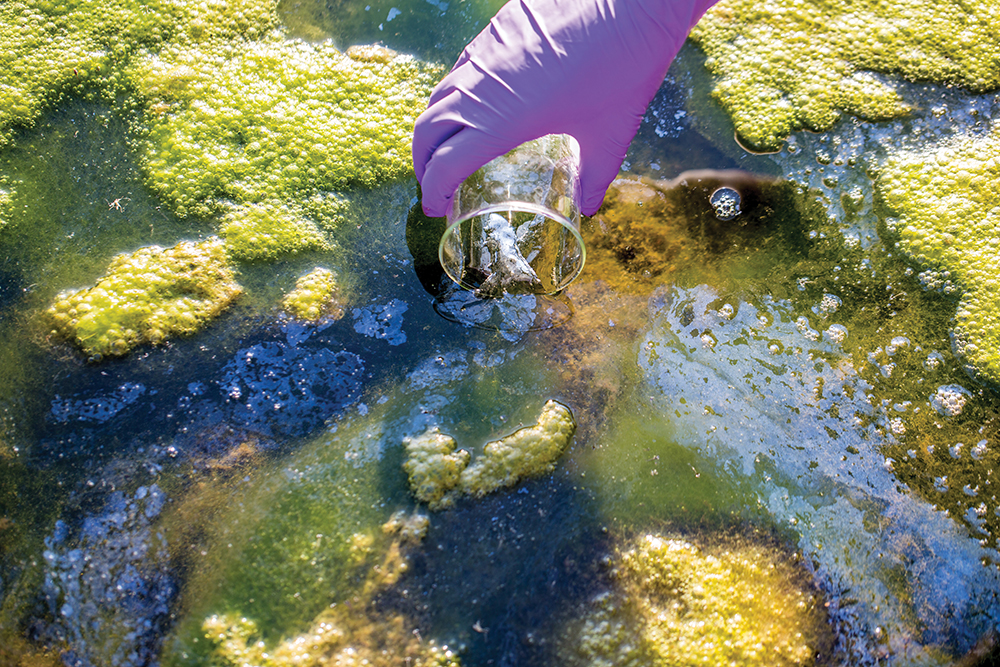A scientist at the University of Bath has for the first time developed a way of monitoring alterations in the aquatic system by listening in to microalgae communicating.
Led by the University of Bath, the research which has been published in Nature Scientific Reports demonstrates that contrary to popular belief, microalgae do communicate with each other when under stress.
The researchers have revealed that under darkness a population of Diatoms – a type of microalgae – produce electrical oscillations. This cell-to-cell communication is believed to be a feedback or survival mechanism as a result of stress due to changes in the microalgae’s physiochemical environment – such as light deprivation and temperature rises. This cell-to-cell signalling is designed to counteract these changes and could result in the formation of algal blooms.
By decoding this form of communication, at the phase where the concentration of cells most increases with time (growth phase), the researchers believe this will provide vital clues to understanding world challenges such as climate change. Algae blooms are an element of climate change where cells multiply at a face pace, which the researchers hope they will be able to better mitigate from this new understanding.
For the first time, the research team were able to listen to the microalgae communicating by recording their electrical interactions extracellularly using sensitive and low resistance multi electrode arrays (MEAs). The recordings, taken over a period of hours, showed Diatom communication is cooperative and synchronized through the whole measured population.
Algae occur naturally in the majority of fresh and salt water. However, climate change is causing an increase in the formation of harmful algae blooms across the world. Warmer waters, high levels of nutrients from increased rain washing agricultural fertilisers into the water, and sufficient sunlight all contribute to the rise in algal blooms.
Algae blooms can be damaging to both aquatic ecosystems and humans. Thick blooms can block sunlight and deplete oxygen levels in the water needed by fish and other organisms to survive, and certain algae can produce toxins that can damage to the human nervous system by contaminating fish which are then eaten as well as causing eye and lung irritation as well as asthma.
Lead researcher and Lecturer in the University of Bath’s Department of Electrical & Electronic Engineering, Dr Paulo Rocha, said: “Algae are the world’s most important ‘plants’. They play a crucial role in the air we breathe, food we eat and pharmacological drugs we take including for cancer. Yet there is only so much we know about these amazing plants.
“One such reason is because there are no methods to actually decode algae behaviours. This project has opened a new page in the understanding of algae signalling and will enable novel sensing technologies to predict the development of algae blooms and of an extensive range of stress-induced alterations in the aquatic ecosystem.”
Director of the Water Innovation & Research Centre at the University of Bath (WIRC @ Bath), Professor Jan Hofman commented: “This is an exciting and important discovery. Understanding how algae behave is extremely important for water security in many areas in the world. Algal blooms have significant impact on water quality and availability, but also can be used in engineered solutions to improve water quality. This project is an excellent example of how important multi-disciplinary water research is.”
This interdisciplinary work has strong scientific and technological implications for probing ecological and physiological stress conditions in algae. It is anticipated that water companies will in the near future benefit from a control technology able to predict and impair harmful and toxic algae blooms by early detecting the onset of algae signals.
In the longer term, this new knowledge could mean cleaner, more natural water and cheaper bills for water consumers as there will be a reduced need for water utility companies to use water treatment chemicals.
The research was a result of an international collaboration between the University of Bath, Delft University of Technology (DUT) in The Netherlands, Instituto Gulbenkian de Ciência in Portugal and the Portuguese Institute for Sea and Atmosphere, I. P.
The article ‘Collective electrical oscillations of a diatom population induced by dark stress’ has been published in Nature Scientific Reports and can be viewed at www.nature.com/articles/s41598-018-23928-9.pdf



